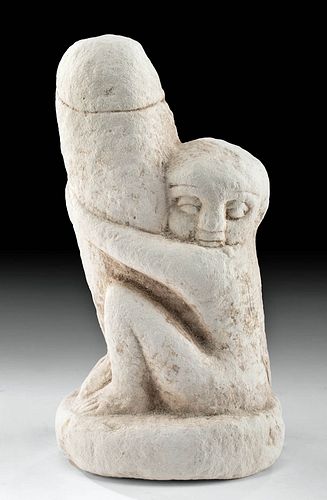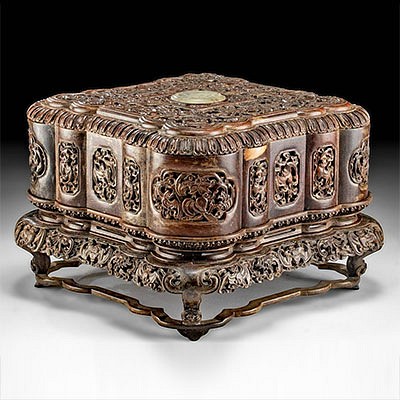Romano-Egyptian Limestone Ithyphallic Figure
Lot 5
About Seller
Artemis Fine Arts
686 S Taylor Ave, Ste 106
Louisville, CO 80027
United States
Selling antiquities, ancient and ethnographic art online since 1993, Artemis Gallery specializes in Classical Antiquities (Egyptian, Greek, Roman, Near Eastern), Asian, Pre-Columbian, African / Tribal / Oceanographic art. Our extensive inventory includes pottery, stone, metal, wood, glass and textil...Read more
Categories
Estimate:
$1,600 - $2,400
Absentee vs Live bid
Two ways to bid:
- Leave a max absentee bid and the platform will bid on your behalf up to your maximum bid during the live auction.
- Bid live during the auction and your bids will be submitted real-time to the auctioneer.
Bid Increments
| Price | Bid Increment |
|---|---|
| $0 | $25 |
| $300 | $50 |
| $1,000 | $100 |
| $2,000 | $250 |
| $5,000 | $500 |
| $10,000 | $1,000 |
| $20,000 | $2,500 |
| $50,000 | $5,000 |
| $100,000 | $10,000 |
| $200,000 | $20,000 |
About Auction
By Artemis Fine Arts
Apr 8, 2021
Set Reminder
2021-04-08 10:00:00
2021-04-08 10:00:00
America/New_York
Bidsquare
Bidsquare : Fine Antiquities | Asian | Ethnographic Art
https://www.bidsquare.com/auctions/artemis-gallery/fine-antiquities-asian-ethnographic-art-6770
Features classical antiquities, ancient and ethnographic art from cultures encompassing the globe. Egyptian, Greek, Roman, Etruscan, Near Eastern, Asian, Pre-Columbian, Native American, African / Tribal, Oceanic, Spanish Colonial, Russian, Fine Art, so much more! All legally acquired, legal to sell. Artemis Fine Arts info@artemisfinearts.com
Features classical antiquities, ancient and ethnographic art from cultures encompassing the globe. Egyptian, Greek, Roman, Etruscan, Near Eastern, Asian, Pre-Columbian, Native American, African / Tribal, Oceanic, Spanish Colonial, Russian, Fine Art, so much more! All legally acquired, legal to sell. Artemis Fine Arts info@artemisfinearts.com
- Lot Description
Egypt, Romano-Egyptian Period, ca. 30 BCE to 2nd century CE. A finely preserved figure of Harpocrates (literally "Horus the child") seated nude atop an integral circular plinth. Harpocrates sits with bent legs spread as both his arms wrap around his enormous phallus, which towers above his head. His face stares outwards with bulging, heavy-lidded eyes and displays full lips, petite ears, and a broad nose. Harpocrates was the god of silence, secrets, and confidentiality, and the ithyphallic symbols were perceived in the Roman period as a good luck charm, specifically for bringing about good fortune. Size: 3.125" W x 5.875" H (7.9 cm x 14.9 cm)
Originally adapted by the Greeks from the Egyptian child god Horus, Harpocrates emerged in late Greek mythology in Ptolemaic, Alexandria. After Alexander the Great conquered Egypt, the Greeks appropriated the Egyptian god Horus to become their deity Harpocrates (literal meaning is "Horus the child"). Horus was regarded as the son of Isis and Osiris who avenged his father's death through several battles with Seth, the legendary god of Chaos. To the ancient Egyptians, Horus symbolized the sun as a newborn.
Provenance: ex-Phoenicia Holyland Antiquities, New York City, New York, USA, acquired before 2010
All items legal to buy/sell under U.S. Statute covering cultural patrimony Code 2600, CHAPTER 14, and are guaranteed to be as described or your money back.
A Certificate of Authenticity will accompany all winning bids.
We ship worldwide and handle all shipping in-house for your convenience.
#162564Expected light nicks/chips and abrasions, commensurate with age and use. Otherwise, intact and excellent with lovely earthen deposits.Condition
- Shipping Info
-
All shipping is handled in-house for your convenience. Your invoice from Artemis Gallery will include shipping calculation instructions. If in doubt, please inquire BEFORE bidding for estimated shipping costs for individual items.
-
- Buyer's Premium



 EUR
EUR CAD
CAD AUD
AUD GBP
GBP MXN
MXN HKD
HKD CNY
CNY MYR
MYR SEK
SEK SGD
SGD CHF
CHF THB
THB














